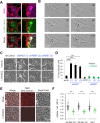RAB7 counteracts PI3K-driven macropinocytosis activated at early stages of melanoma development
- PMID: 26008978
- PMCID: PMC4494909
- DOI: 10.18632/oncotarget.4055
RAB7 counteracts PI3K-driven macropinocytosis activated at early stages of melanoma development
Abstract
Derailed endolysosomal trafficking is emerging as a widespread feature of aggressive neoplasms. However, the oncogenic signals that alter membrane homeostasis and their specific contribution to cancer progression remain unclear. Understanding the upstream drivers and downstream regulators of aberrant vesicular trafficking is distinctly important in melanoma. This disease is notorious for its inter- and intra-tumoral heterogeneity. Nevertheless, melanomas uniformly overexpress a cluster of endolysosomal genes, being particularly addicted to the membrane traffic regulator RAB7. Still, the underlying mechanisms and temporal determinants of this dependency have yet to be defined. Here we addressed these questions by combining electron microscopy, real time imaging and mechanistic analyses of vesicular trafficking in normal and malignant human melanocytic cells. This strategy revealed Class I PI3K as the key trigger of a hyperactive influx of macropinosomes that melanoma cells counteract via RAB7-mediated lysosomal degradation. In addition, gain- and loss-of-function in vitro studies followed by histopathological validation in clinical biopsies and genetically-engineered mouse models, traced back the requirement of RAB7 to the suppression of premature cellular senescence traits elicited in melanocytes by PI3K-inducing oncogenes. Together, these results provide new insight into the regulators and modes of action of RAB7, broadening the impact of endosomal fitness on melanoma development.
Keywords: endosomes; macropinocytosis; oncogene-induced senescence; oncogenic stress; small GTPases.
Conflict of interest statement
There is no conflict of interest.
Figures





References
-
- Mosesson Y, Mills GB, Yarden Y. Derailed endocytosis: an emerging feature of cancer. Nat Rev Cancer. 2008;8:835–850. - PubMed
Publication types
MeSH terms
Substances
LinkOut - more resources
Full Text Sources
Other Literature Sources
Medical
Molecular Biology Databases

